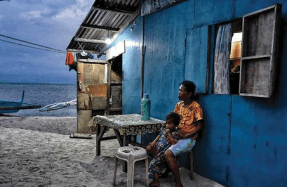

ONE NIGHT IN JANUARY, I found myself strolling through gardens enclosed with white picket fences, in which various objects made of plastic and fibreglass were lit up in bright colours. Coconut palms, mushrooms, deer, swans, horses, crescent moons, reindeer, giraffes, giant sunflowers and tulips, rabbits and flamingos, interspersed with LED fountains, produced a neon-lit landscape. I was at the Unity Glow Garden, which is part of the Kevadia Tourism Circuit, newly instituted by the Gujarat government around the Sardar Sarovar dam. The circuit currently comprises 35 destinations and experiences, including a number of parks and gardens, a zoo and jungle safari, a river cruise, adventure-sports facilities for rafting and cycling, shops, malls, restaurants and hotels catering to a variety of budgets. That this is more than simply a place to have fun is underscored by the names of all these attractions. Tourists can visit the Ekta Nursery—which describes itself as producing “Plants of Unity”—take an Ekta Cruise on a boat named Unity, shop at the Ekta Mall, eat at the Ekta Food Court or soak in the delights of the newly named Ekta Nagar, the nocturnal highlight of which is the Unity Glow Garden.
At the heart of the circuit is the Statue of Unity, currently the tallest statue in the world, built to commemorate Vallabhbhai Patel—India’s first home minister and a leading figure of the freedom struggle. As the name of the statue indicates, Patel is commemorated principally for his role in creating the Indian state by persuading over five hundred princely states to join the Indian Union after Independence. Conceptualised by Narendra Modi in his tenth year as chief minister of Gujarat, in 2010, the Statue of Unity began to take shape with a foundation-laying ceremony on 31 October 2013—Patel’s birth anniversary—just as Modi was about to begin his campaign as the Bharatiya Janata Party’s primeministerial candidate for the following year’s general election. It was inaugurated on 31 October 2018, when Modi began campaigning for a second term as prime minister. A day before the inauguration, nearly three hundred activists, many of whom were Adivasi farmers, were detained to pre-empt a massive protest against the statue, the construction of which had resulted in the expropriation of their land.
Because the Hindu Right’s ideological forerunners lack a substantial presence in the pantheon of leaders of the freedom struggle, the BJP has taken to appropriating figures from within the Congress fold, such as Patel and Subhas Chandra Bose, who disagreed at various junctures with positions advocated by Jawaharlal Nehru and MK Gandhi. In recent years, a smattering of biographies by amateur historians, two of which were published in the year that the Statue of Unity was inaugurated, have mined a rich vein of grievance on Patel’s behalf. Based less on his writings—of which there are few in comparison with those left behind by the more prolific Gandhi and Nehru—and more on an imagined sense of what Patel might have done were he not to have played second fiddle, these works seem driven by an ambition to tell his “side” of the story and to restore him to his rightful place in history. High on the list of complaints is Gandhi anointing Nehru, rather than Patel, as Congress president on no less than three occasions: in 1929, 1937, and 1946, when presidency of the Congress also brought with it leadership of the interim government and, ultimately, the position of first prime minister. On the last of these instances, Gandhi’s preference overrode the nomination of Patel by 12 of the 15 provincial Congress committees. “Gandhiji, through his undemocratic, dictatorial and unethical intervention, and Nehru, through his greed and ambition for the top position, deprived Sardar Patel of his position as the first Prime Minister of India,” Rajnikant Puranik writes in Sardar Patel: The Best PM India Never Had. Puranik, who describes himself as a physicist, banker and software professional, seems to have made a career out of publishing books critical of Nehru and Gandhi, with titles such as Nehru’s 97 Major Blunders.
In an earlier scholarly biography of Patel, the historian Rajmohan Gandhi speculates that his grandfather chose Nehru as his political heir on account of his age, his appeal to younger voters, Muslims and socialists, his international experience and profile, and, somewhat ironically, his greater anglicisation, which, in Gandhi’s view, made him a better interlocutor with the British. In addition, confident of Patel’s absolute loyalty to himself and to the party, that many Congress presidents had been older than Patel was when he was first passed over in 1929. And, while accepting that Patel was in poor health at the time of Independence, Sengupta insists that, if Patel had had the strength to complete the challenging task of integrating the princely states, he may have been capable of a great deal more. For Patel’s votaries, India would have been spared the scourges of Nehruvian socialism and secularism if their man had been at the nation’s helm in its formative years.






